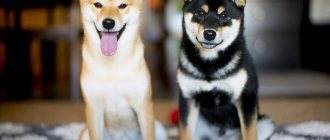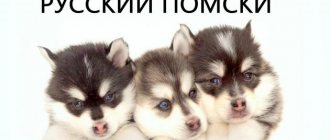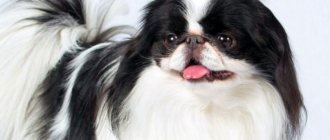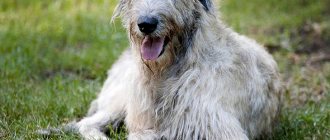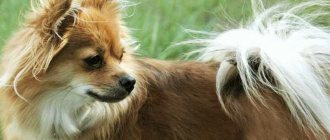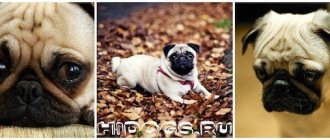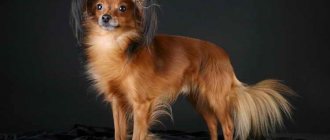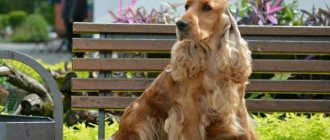Shiba Inu: the smiling dog with the heart of a samurai
The Shibu Inu is a Spitz-type dog from Japan, notable for its charming smile and sly look. The Shiba Inu is very similar to the Akita (star of the film “Hachiko”), but is smaller in height and weight. It is considered the smallest native Japanese dog.
The Shiba Inu, like other four-legged inhabitants of the islands, is a Japanese national treasure and is protected by the canine organization Nippo.
What does an adult Shiba Inu look like in a photo?
Shiba Inu are medium-sized dogs, occupying a middle position between small and medium-sized breeds.
The height at the withers for males is 38–41 cm, for females – 35–38 cm . The weight of an adult male is 10-15 kg, females - 8-9 kg. In rare cases, the weight of a Shiba Inu can reach 20–22 kg.
Adult Shiba Inu are dogs with a strong, proportional build, well-fed, but without a tendency to be overweight.
Representatives of nature have a small head, the muzzle is slightly elongated and pointed . The skull is wide with developed cheekbones, the body is slightly elongated relative to the legs.
The eyes are small and brown. The ears are small, erect, triangular in shape. The limbs are strong, but refined. The dog has a strong bone structure, but at the same time it is quite graceful. There is no heaviness or heaviness in it.
The coat of the Japanese husky is thick, dense, and moderately hard . The undercoat is short, soft and dense. The most popular color is red in various variations.
Acceptable colors also include:
- Black and tan.
- Red.
- Sesame (a mixture of black and white hair with a predominance of black).
Shiba Inu breed standards
The main working feature of the breed is considered to be short stature. Thanks to its small size, even an adult Shibu Inu dog can easily get through dense thickets while hunting small game.
“Sibainu” is translated into Russian as “dwarf dog.” "Shiba" is an old variant of the word "chibi", which means "small" in the Honshu dialect.
In the mid-1930s, the FCI standardized the description of the Shiba Inu internationally.
- triangular ears slightly tilted forward;
- pointed fox face;
- eyes are dark brown (the outer corners are located higher than the inner corners);
- nose with black lobe;
- scissor bite;
- a toned body with a flat back, muscular lower back, deep chest and dry belly;
- massive hocks and springy paw pads with dark nails;
- a thick, ring-shaped tail covered with thick and fluffy hair.
Thanks to the sly squint and black edging of the lips, it seems that the Shibu Inu is smiling.
On a note. In addition to the international breed standard, there is also a Japanese standard, according to which the size of an adult dog differs depending on gender. Dogs are larger, more muscular and more aggressive, while females are smaller and more good-natured.
The approved description of the Shibu Inu excludes:
- cowardice;
- drooping ears;
- tail docking.
Despite the visual similarity with the Akita, the Shiba Inu has a smaller body size:
- The weight of male Shiba Inu reaches 10–13 kg, and females – 7–10 kg.
- The height of the Shiba Inu at the withers varies from 35 to 41 cm, depending on the gender.
But the parameters of an adult Akita are much greater than those of a Shiba. Akita Inu weight reaches 50 kg and height – 67 cm.
Important. In order for your Shiba Inu puppy to grow up healthy, you need to monitor your pet’s weight.
Shiba Inu weight and height chart by month
For every day of life, a Shiba grows several grams larger. The most intensive period of growth is considered to be the first 6 months, and by 9 months the pet’s weight corresponds to the standard of an adult dog.
Unlike weight, height indicators are more individual. They depend on many factors, including nutrition and the innate characteristics of the animal.
Below is a table of Shiba Inu weight by month:
Shiba Inu colors
Shiba Inu dogs have a rich coat with a soft undercoat and a harsh coat. The longest hair is on the tail, and the shortest is on the face and limbs.
Acceptable colors include:
- Ginger. Occurs in 80% of representatives.
- Black with silver or tan markings
- Zonal.
The latter is characterized by double coloring of each hair:
- sesame – uniform distribution of white and black zones;
- black sesame – black predominates over white;
- red sesame - a combination of red color with black color at the very tip of each hair.
On a note. Shiba dogs with white color are not allowed by the standard.
On the fur of purebred animals, “urajiro” is required - a pattern of white wool, covering the following parts of the body:
- chin;
- cheekbones;
- stomach;
- neck;
- chest;
- tail and limbs from the inside.
How does a Shiba Inu differ from an Akita Inu?
We often hear that these Japanese dog breeds are confused. In fact, both of them are original and have differences. For example:
Why a Shiba Inu might not be right for you
Obviously, the cute appearance of the dog in question is somewhat deceiving. The Shiba Inu is not a dog for everyone. This four-legged friend will not suit you if:
Important! If you do not devote enough time to your pet, he will begin to throw out energy on things - gnawing wooden objects and shoes, as well as tearing fabric toys and interior items.
Who is the Shiba Inu suitable for?
You should choose this four-legged friend if:
Character and behavior
The main feature of the Shiba Inu is the unacceptability of servility. This character trait requires exclusively partnerships.
"Mini Akita" can be described by the following characteristics:
- Devotion. Shiba dogs perceive humans as equals.
- Restraint. Despite their devotion, Japanese dogs are very reserved in their feelings. In this way they resemble samurai, ready to do anything for their master.
- Dominance. The “Japanese” do not like other four-legged animals and try to crush them under themselves.
- Activity. The Japanese dog breed is suitable for active owners involved in sports. The animal will happily take part in games and morning runs. However, it all depends on the wishes of the pet. He even brings the ball not at the command “fetch”, but at his own request.
- Developed hunting instinct. Having noticed possible prey, the animal loses control and follows the target, guided by its own considerations.
Japanese dogs are indifferent to strangers, but prefer to keep their distance. Aggression on the part of a Shiba is possible only with importunity.
Shiba Inu and children
With proper upbringing, the Shiba Inu dog perceives children positively and even tolerates their pranks.
Features of care and maintenance of Shiba Inu
This dog feels great in an enclosure or apartment. But it is important to take into account some features of its content.
Those who keep a dog in an apartment should know that this four-legged friend should be walked 2-3 times a day. And these should not just be walks around the house, but active games and grueling workouts. Otherwise, the Shiba will begin to damage things and furniture.
Moreover, like a magpie, she loves unusual things and strives to take possession of them. If necessary, she will even climb high shelves and closets. And not from a desire to harm, but solely from curiosity and a desire to play.
If you keep your dog outside, remember that he does not tolerate collars or leashes. It needs to be kept in an enclosure, but it should have a cozy booth with a soft bed inside.
But even if a Shiba has an enclosure, it must be periodically released into the wild, giving it the opportunity to run and play.
Important! You need to clean your dog’s ears and teeth, and trim his nails every 7-10 days. But you only need to bathe such a dog if he is very dirty (about once a month).
It is necessary to comb your Shiba 2-3 times a week, and in case of shedding - every day. The fact is that the dog sheds quite actively, and if you do not want to find fur on the floor and interior items, take the time to comb it.
Important! It is advisable to comb your Shiba against the grain. This will remove more loose hairs and stimulate blood circulation in the layers of skin necessary for the growth of new hair.
How to choose a Shiba Inu puppy?
A Shiba puppy is an expensive pleasure. Prices start from 50 thousand rubles and depend on the class to which the future pet belongs. The most expensive is considered to be the show class, which means the exterior perfectly matches the standard.
Such puppies are purchased from large licensed nurseries. In Russia they can be found in Moscow or St. Petersburg. If you buy a pet for the soul, then you can save money and turn to private owners.
In this case it is important to check:
- Reviews about the breeder. Legal activities are carried out only under the guidance of the kennel club.
- Parents' appearance. If the breeder refuses to demonstrate, refuse to buy. Dogs may be sick or mongrel.
- Appearance of the litter. Study your chosen puppy carefully. He must be active, well-fed and well-groomed.
- Availability of documents. Along with the puppy, the breeder must submit birth certificate, pedigree and veterinary passport.
Nicknames for Shiba Inu
The pet can be called by any euphonious name of several syllables. It should be clear and easy to understand, so versions from the dog passport that are too long will have to be shortened.
As a rule, Shibu is called Japanese names with an unusual meaning:
A nickname for a Shiba Inu boy can emphasize his strong-willed qualities and impressive appearance:
- Fugue – elegant;
- Taishi – ambitious;
- Hiro is a hero;
- Ken – strong;
- Kabuto - Japanese helmet;
- Heishin is the favorite;
- Izamu – brave;
- Mamoru is a protector;
- Takeshi – noble;
- Yasuo is honest.
Names for Shiba Inu girls may have a softer meaning:
- Momo – peach;
- Ai – love;
- Makoto – sincere;
- Ren – water lily;
- Kaoru – aroma;
- Hana – flower;
- June – obedient;
- Hoshi – star;
- Minako is a beautiful child;
- Chow is a butterfly.
Origin
Shiba Inu, Shiba Ken and Shiba Inu (official name) are synonyms. "Siba" lane from Japanese as “small”, the words “ken” and “inu” - dog.
Wild Japanese dogs lived on the islands as early as the 5th century BC. From them came all the indigenous breeds of Japan, including the Shiba Inu. Small dogs were valued by hunters for their agility and ability to work in dense thickets, where the speed of larger inus is reduced.
Thanks to enthusiasts, the original appearance was preserved strictly according to the description of the Shiba Inu breed. To avoid a repetition of the situation, they were declared a national treasure of Japan. They are very popular as companions in their homeland and in the USA. There are also many excellent nurseries and loyal fans in Russia.
Outwardly, the Shiba Inu does not stand out among other Asian Spitz dogs: strong build, not overweight, natural proportions, tucked belly. Height varies from 37 to 41 cm. This is the smallest representative of the group.
The pointed muzzle should not be narrow. Slightly slanted small eyes with a cunning look, a firm and tenacious gaze. The erect ears are slightly tilted forward, giving Shiba a concentrated appearance. The thick tail can be straight or curled.
The coat of a typical Spitz is a harsh guard and a soft, short undercoat. Due to the thick fluff, the fur is raised, but an adult Shiba Inu, unlike a puppy, should not be very plush.
In the “black sesame” version, the Shiba Inu looks bright and unusual.
For all colors, a white lower part of the body is required - chin, throat, chest, belly, inside of the paws and tail. The white fur on the muzzle forms a mask, covering the cheekbones and eyebrows.
Color options
The standard describes several types:
- ginger;
- black and tan;
- sesame (white and black hairs in equal proportions);
- black sesame (there are more black hairs than white ones);
- red sesame (black and red hairs with an earthy tint).
All-white Shiba Inus are very impressive. But such puppies can only be considered as pets, without plans for exhibitions or breeding - they do not correspond to the description of the breed standard.
A fairly rare color of the Shiba Inu is red sesame.
Origin of the breed
The island of Honshu (Japan) is home to 6 breeds of hunting dogs. Their name corresponds to the name of the province in which they originated. And only the Shiba Inu is named based on its external characteristics.
The ancient origins of Japanese hunting dogs are evidenced by finds discovered by archaeologist Angela Perry. In the scientific literature of Japan, she discovered descriptions of burials of hunting dogs similar to the Shiba Inu.
More than 9,000 years ago, hunters in Honshu honored dogs by burying them with the hunters. The dogs were laid down as if the dog was sleeping peacefully, curled up. Next to the dog were funeral bracelets and belts inlaid with deer antlers. These burials indicate that the ancient Japanese honored their assistants on a par with the hunters who obtained food for the tribe.
In addition to 110 burials dating back to before 300 BC, Perry discovered a 2,500-year-old bronze bell depicting scenes of a wild boar hunt with Shiba Inu-like dogs. Beginning with the Jomon period (16,000-24,000 years ago), the Japanese selected dogs for desirable traits.
After the arrival of Korean settlers on the island, the crossing of indigenous breeds with emigrant dogs took place, and in the 18th-19th centuries. with other European breeds. Island breeds are on the verge of extinction. Thanks to the efforts of NIPPO, the Society for the Preservation of Aboriginal Dog Breeds, they were restored.
4 nuances worth knowing
The Shiba Inu is the smallest native Japanese dog. It is preceded by such breeds as Akita Inu, Kai, Hokkaido, Kishu and Shikoka. At one time there were seven breeds. But the seventh - kosi - is considered completely lost today. Listed below are four interesting facts about the Dwarf Japanese Husky that provide a colorful addition to the breed's history.
- Miniature dwarf. The size of an adult Shiba Inu should be at least 36.5 cm. But in Japan there are still miniature Shibas, whose height at the withers ranges from 19 cm to 30 cm. The breed standard does not recognize such individuals, however, small dogs are no less loved and revered in their homeland.
- Very rare. The rarest are the Shibas, which have a pure white coat. As a rule, the price of such puppies is frighteningly high. But even an acquired pet is exclusive in its purest form.
- On the verge of extinction. The Second World War almost wiped the breed off the face of the earth. And only in the late 40s of the last century, with the support of the state, Nippo began to restore the population. For this purpose, a group of surviving dogs that were closest to the standard was selected.
- Features of national breeding. Officially, three organizations are involved in breeding Shiba in the Land of the Rising Sun. One of them is Nippo. The other two are Shibaho and the Japanese Kennel Club. It is noteworthy that Shibaho includes white Shiba Inus in the standard, but colleagues from Nippo and the Kennel Club do not.
Character, relationships
All Nippon Inu (Japanese native breeds) have a similar disposition: independent, courageous, without a hint of servile worship. They accept only equal partnership and seem to provide a friendly service rather than obey commands.
“He’ll bring you the ball. But there will be a special reason for this” - a quote about the Akita Hachiko, perfectly describes the Shiba Inu. At first glance, he may seem stubborn, unsociable and gloomy. It's not like that at all!
They love the owner and the whole family. They highly value attention and respect from their family. They behave restlessly if you ignore your pet for a long time. However, violent manifestations of feelings are very rare. In their homeland they are compared to samurai - reserved, but endlessly loyal.
The “pack” is expected to treat itself in the same way. With rare exceptions, Shiba Inus do not tolerate intrusive, prolonged petting. Although, depending on the mood, the pet is happy to expose its tummy for scratches. They also play according to their mood, cheerfully indulging in fun without regard for their reserved character.
Relationships with children develop differently. If this is a schoolchild to whom the rules of communication have been clearly explained, the Shiba Inu will become a wonderful friend. Adult dogs are more patient with children. They may resort to “disciplining” a playful little one - without self-harm, but with a noticeable bite.
They are wary or indifferent to strangers. They are reluctant to make contact, taking an observant position. Aggression towards the intrusive “alien” is possible. Growing up on the couch reinforces our innate tendency to keep our distance.
Among the representatives of the breed there are many dominant individuals who are aggressive towards other dogs of any gender. It is often written that the attitude towards cats is also hostile. But, according to reviews from the owners, Shibas get along well and are even friends with Murkas, provided they are properly raised.
Breeders strongly recommend choosing a nursery based on the conditions of the litter. If there are children in the family, then the Shiba Inu puppy should grow up surrounded by children from the first days. Are there cats at home? Look for a cattery where cats are allowed into the nursery with the puppies.
Shiba Inus get along well with cats, provided they are introduced to them from puppyhood.
Training and education
A dog's training should begin with its early socialization. Shiba Inu should be taught from childhood the rules of good dog behavior: do not shit in the apartment (or in a strictly designated place for this), do not beg for food from the table, do not encroach on the lives of other pets and calmly react to animals during a walk, do not bother owner and listen to his commands unquestioningly. A trained dog is one that does not force the owner and other household members to live solely in its interests. From an early age, a Shiba Inu puppy needs to be taught its own name and behave calmly and moderately strictly with the animal. You should not raise your voice or hit the dog. But such a breed should not be overly fertilized even after the command has been successfully completed. It is enough to praise the dog verbally, only occasionally giving a treat. And a Shiba Inu should never be allowed to show unreasonable aggression towards people and animals; the dog should receive punishment, which may consist of minor physical impact and appropriate voice intonation. Shiba Inus should be trained on a leash, collar and muzzle from an early age to avoid tragic situations.
Experienced dog owners advise in no case to limit themselves to home training, but to complete a basic training course with the dog yourself (you can study the relevant literature; there are many video lessons on this topic on the Internet) or contact a specialist. A general training course allows you to teach (or improve skills given at an early age) a dog the following commands: “Come to me”, “Sit”, “Nearby”, “Walk”, “Stand”, “Lie down”, “Fetch”, “Face” and others. The dog must be adapted to life in society and calmly respond to the sounds of gunfire, signals, and noise. It is advisable to seek the help of a training instructor, since Shiba Inus are very capricious. It is easy for an owner to make mistakes when training. But initial training in simple commands still needs to be done independently in order to establish contact with the animal.
Features of walks
The described disobedience can be activated at any moment, but more often the “I can’t hear anyone” mode turns on during walks. The hunting instinct, an innate desire to explore, aggression towards other dogs - there are a lot of reasons for bad behavior.
At such moments, the pet will not even turn his head to the cry “Come to me.” And he can easily run away, without any fear of losing sight of the owner. That is, the usual “turn around and leave” tactic in such cases is unlikely to work.
In the city, even a well-mannered Shiba Inu can only be walked on a leash. Many breeders recommend unfastening the leash only in a fenced area.
Socialization reduces the incidence of problems. In addition, without accustoming Shiba to an eventful street environment, there is a high probability of developing “touch-me-not syndrome.” Aggression or cowardice will prevail in any unusual situation.
Prioritize meaningful activities over simply wandering around the yard.
The curious Siba loves walks. And he plays with pleasure if the contact between him and the owner is established. The need for physical and mental exercise is high - the breed is not suitable for people who are busy from morning to evening.
You shouldn’t expect super speeds and prizes in agility, but it’s just the thing as exercise for the body and relaxation for the mind.
Already at the age of two weeks, many puppies react violently to attempts at physical restraint: they squeal, hiss, scream and protest with the most unimaginable sounds. By the way, Sibas rarely bark. But the range of other sounds produced is incredibly wide.
Punishment for such behavior will only do harm - the final loss of trust will lead to zealous resistance to any manipulation. Dogs of this breed are trained to be groomed daily like cats! That is, without coercion, gently, after active games, acting confidently and calmly.
Resists? Distract and try again. And further. And so on until complete surrender. Of course, if instead of “death screams” aggression is turned on, by the scruff of the neck and to the floor.
A natural appearance without a “show of frills” implies easy care for your pet. But wool requires regular attention. They shed profusely, seasonally. Males undress under stress from sexual arousal, females - after each heat, after childbirth.
As a rule, molting lasts about a month, except for junior ones: the change of coat to an adult fur coat can take three months, and sometimes longer. Vitamins cannot be given during this period - the molting will be delayed.
To speed up the process, breeders recommend brushing a shedding pet daily. It is convenient to work with a slicker or rotating rake - they do not damage the awn, easily “picking out” the dying fluff. You cannot comb it dry - first the wool is slightly moistened with a special oil or conditioner.
A furminator, a rake with two rows of blades, removes undercoat well. Sometimes one or two brushings are enough to stop shedding. But if you lack experience, you can cut the spine, which will take several months to recover. Therefore, the Furminator should not be used on show dogs.
If your dog has faded to bald spots in winter, we recommend wearing overalls when going for a long walk. If shedding is moderate, there is no need to insulate - Sibas tolerate cold as well as heat.
Water treatments
The Shiba Inu is not easy to bathe due to its rich undercoat.
- The fur coat gets wet only on top, remaining absolutely dry in its thickness. To rinse the wool well, you need to shower it for a long time against the growth direction, periodically squeezing the strands.
- It is advisable to use professional shampoo. Human cosmetics quickly dry out the hair, which leads to constant molting.
- After bathing, the wool is blotted with absorbent chamois. It is sold in car dealerships (the quality is no worse, and the price is several times cheaper than the “special” dog one). An ordinary towel will not remove even half the moisture from a thick fur coat.
- They wash the Shiba Inu at night, so that at least 8 hours pass before the first walk after bathing. Exceptions are made only in the summer in good weather, when there is no danger of hypothermia in a draft. The dense undercoat remains wet for a long time, although at a glance it seems that the pet is already completely dry.
- It is better not to use a hairdryer unless necessary, especially if it is not a professional tool (it will dry out the hair). Preparation for the exhibition is elementary, but there are still some tricks - take a couple of lessons from the breeder.
You are on the right track if your dog looks like this when bathing.
All native breeds of Japan are distinguished by good health. Among them there are often long-livers who remain in good shape into old age. Of course, subject to proper maintenance, proper feeding and genetic “purity”.
The list of hereditary diseases is small. The main problems include diseases of the eyes and joints: osteochondritis, patella, dysplasia of the elbow/hip joint. But since the Shiba Inu is average in size, joint ailments are less common than, for example, among larger Akitas or Molossers.
However, the choice of a nursery must be approached responsibly, since congenital diseases cannot be treated or are difficult to treat. The Shiba is not the most popular breed, but due to the high cost of puppies, there are commercial breeders available for breeding. It is advisable that both parents of the litter have documents confirming genetic health.
Breed characteristics
The handsome Shiba Inu are representatives of the original Japanese breed. These animals are recognized as a real treasure of the Land of the Rising Sun. However, by the 20th century, these charming miniature hunters almost disappeared.
Fortunately, the Japanese managed to cope with this problem - they restored the population and increased it.
The ancestors of the Shiba Inu were highly efficient hunters who helped humans hunt for game. Most often it was venison, but it could also be bear meat. Standards for this popular breed were established in 1934.
Today, many people are literally in love with these cute and attention-grabbing pets. Before you acquire such a four-legged companion, it is worth considering its description in detail.
- It is important to consider the weight of these animals. Typically males weigh between 10 and 13 kg. Females are lighter and neater. As a rule, their weight is 7-9 kg.
- At the withers, the height of a healthy adult male should be 39.5 cm. Female dwarf dogs, as a rule, grow up to 36.5 cm. In both the first and second cases, small deviations from the norm are permissible - 1.5 cm more or smaller side.
- The coat color of these charming animals is red, wolf (or zonal), white, tan, black and tan.
- Many breeders are interested in the life expectancy of little hunters. Shiba Inu are among the record holders for this indicator - on average they live from 12 to 15 years. Of course, we must also take into account the living conditions in which the animal is kept. Depending on this, the dog may live longer or shorter.
- The character of the Shiba Inu is quite brave and strong-willed. These cute-looking animals are distinguished by great endurance - they are able to endure many trials. This is due to their hunting background. Shiba Inus are active. They love freedom. The person who got such an animal must be as authoritative as his pet. Otherwise, the relationship between the owner and the dog will not work out in the best way.
Let's get acquainted with the basic standards of appearance of this funny Japanese dog.
- The body of the Shiba Inu is quite strong. The muscles are well developed. The body structure is proportional.
- The back is slightly wide and straight.
- The chest is also distinguished by well-developed muscles. In addition, the Shiba Inu's chest is quite deep.
- The belly of these dogs does not hang and does not protrude much - by nature it is lean and dry.
- The front legs of this breed are strong and have characteristic dense elbows. The latter are pressed against the body of the animal. The hind legs are distinguished by muscular thighs and great length. The pads are also well developed - they are quite dense, with tucked claws. During normal walking and jogging, all paw movements are light, smooth and free.
- The Shiba Inu's neck has a simple normal structure without noticeable features. This part of the body is well developed and not thin.
- The head is impressively wide, but does not have a flat structure. The shape is correct - round.
- The nose of these dogs is moderately long. There is an expressive transition from the forehead to the muzzle. The bridge of the nose smoothly and neatly “flows” into a well-developed and large dark-colored lobe.
- The Shiba Inu's eyes They have a characteristic triangular shape. The look of these Japanese beauties is expressive and attention-grabbing. The outer edge of the eyes is slightly raised.
- The lips are fleshy and fit closely to the teeth.
- The ears of representatives of the Japanese breed are set high. They stand and have a triangular structure.
- The tail of dogs is set quite high. It is characterized by a dense structure. It has a “ring” shape. When unfolding, the tip of the tail should reach the base of the hock joint.
- As for coat , it consists of an undercoat and a guard. It should be taken into account that the latter is not very soft and tender, but is not wiry either. In the area where the tail is located, the fur is longer, and on the muzzle and paws it is short.
- The standard coat color of the Shiba Inu is represented by three main colors. Red, sesame and tan colors are allowed. The most common color is red. 80% of all representatives of the breed are carriers of this particular coat shade. Sesame color usually consists of unevenly colored hairs covering a specific area. The traditional coloring of the Shiba Inu has a black or reddish base. The lightest hairs, almost white in color, are usually located on the animal’s face and on the inside of the paws.
This color of coat is considered a real calling card of the Japanese breed and is called “urajiro”. If such a lightened mask is not visible or it is too snow-white, then the dog is simply rejected.
Description of the breed
The Shiba Inu is a primitive breed. Many note her resemblance to a fox. The dog is small, but not dwarf. The height of an adult male at the withers reaches 38.5-41.5 cm, and that of a female - 35.5-38.5 cm. The weight of the animals ranges from 8-10 kg. The dog is perfectly balanced, there are no features in it that would attract too much attention. The paws are not long or thin - they are proportional to the body. In terms of manners, Shiba can be compared to a cat. The dog is lively and strong, has a proud posture and a body silhouette that fits into a square.
- What determines the size of the old-age pension - calculation procedure
- 10 ways to improve memory after 50 years
- Free vouchers to a sanatorium for pensioners - how to get and get in line, documents and registration
What does a Shiba Inu dog look like?
Externally, the dog is well built and has strong muscles. The animal's muzzle is very reminiscent of a fox. The transition to it from the forehead is very pronounced. The skull is wide, the muzzle tapers towards the nose. The pet has a tail set high on its back, curled into a ring, and compact paws. As for color, this breed is characterized by many different shades, including brindle, sesame, white, black and with red or yellow tan. A distinctive feature is the presence of lightened areas on the chest, neck, muzzle, and abdomen.
International breed standard FCI
As a separate breed, the Shiba Inu is recognized by the international cynological community FCI. According to their version, this dog is a proportionally built pet designed for hunting small game. The animal is characterized by an independent and lively temperament, sharp and dexterous movements. As for the characteristics of the physique itself, according to the FCI standard, it looks like this:
- The head is wide in the forehead area, has a pronounced bend at the transition to the muzzle. It shouldn't be spicy. A dividing furrow runs from the forehead to the back. The lips are thick and close fitting.
- The nose has an almost square lobe; there cannot be lightened colors. The back is straight.
- The eyes are slanted and almond-shaped. Their color is in the brown palette, as saturated as possible.
- The ears are triangular, small, do not bend forward too much, and have thick, hard cartilage.
- The body is proportionally built and has developed muscles. The curve of the ribs is clearly visible on the chest. The neck is thick, short, and oval in cross-section. The back is straight, strong, wide. The withers are clearly visible, as is the loin with a sloping croup.
- The tail is thick, powerful, reaching the hock joints when extended. Carried over the back in the form of a tight ring.
- The limbs have inclined shoulder blades, elbows pressed to the body. The hind legs are more powerful than the front ones, have elongated femurs and short lower legs. The hock joints are clearly defined against the background of the overall silhouette of the hind legs.
- The teeth are white, even, strong. Scissor bite, correct.
Evaluation criteria in the NIPPO standard
For most dogs, the FCI description is relevant and the only one, but with Shiba the situation is different. The primary standard is adapted for a public framework, but for judging it is necessary to respect the nuances prescribed in NIPPO. This is a Club for the Protection and Preservation of Japanese Dogs. She maintains a registry of 6 indigenous breeds in Japan, including the Shiba Inu. The organization is also developing a standard for it. Many national exhibitions are held under the auspices of NIPPO.
This organization's description for Shiba Inu complements the FCI standard. It is worth considering that the NIPPO criteria are only met for the evaluation of one breed. If the exhibition is all-breed, then a dog that does not meet the parameters cannot be rejected. In addition to the FCI standard, NIPPO has the following requirements:
- Pronounced sexual dimorphism. Regardless of age and size, a male dog must produce a masculine impression. This is manifested by strong bones, a decisive look, and a courageous expression on the muzzle. Bitches, in comparison, should be refined and harmonious, with a gentle, meek look, even if they are naturally large girls.
- Strict geometry of the head and body. Proportions are very important when evaluating. Even such a feature as a large nose can be rejected. Exceeding certain dimensions is considered non-compliance with the standard. Some of the criteria presented in this category are:
- the height of the female is 35-38 cm, and the height of the male is 39.5 cm;
- height to body length ratio – 1:100;
- proportions of the lengths of the head and front part – 100:40;
- withers to pastern girth – 100:110.
